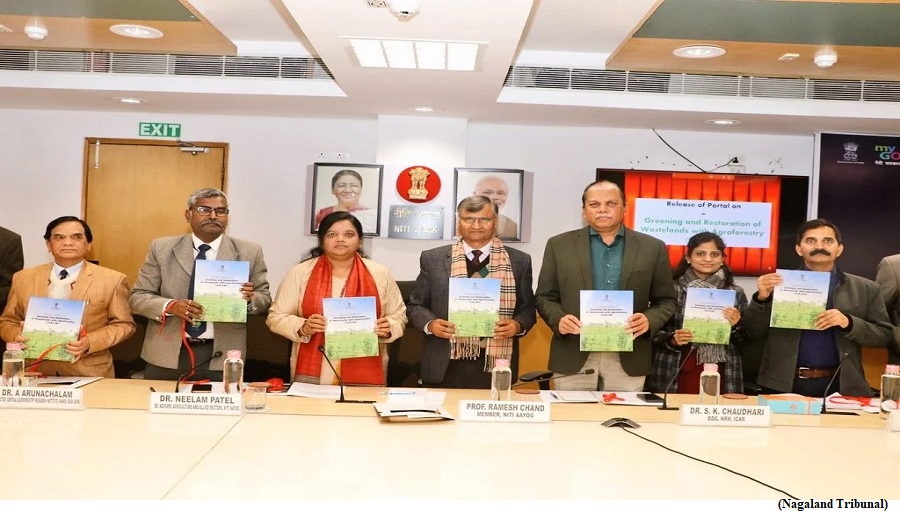NITI Aayog Launches Greening India Wastelands with Agroforestry (GROW) Report and Portal (GS Paper 3, Environment)

Why in news?
- Greening and Restoration of Wasteland with Agroforestry (GROW) report and portal was launched recently by the NITI Aayog.
- This multi-institutional effort led by NITI Aayog utilized remote sensing and GIS to assess agroforestry suitability across all districts in India.
Why it matters?
- Using thematic datasets, an Agroforestry Suitability Index (ASI) was developed for national-level prioritization. The report provides state-wise and district-wise analysis, supporting government departments and industries for greening and restoration projects.
- The "Greening and Restoration of Wasteland with Agroforestry (GROW)-Suitability Mapping" portal Bhuvan allows universal access to state and district-level data.
- Currently, agroforestry covers 8.65% of India's total geographical area, totalling about 28.42 million hectares. Current report underscores the potential benefits of converting underutilized areas, especially wastelands, for agroforestry.
- The GROW initiative aligns with national commitments, aiming to restore 26 million hectares of degraded land by 2030 and create an additional carbon sink of 2.5 to 3 billion tonnes of carbon dioxide equivalent.
Why agroforestry?
There is need for promotion of agroforestry especially for three things i.e.
- reducing import of wood and wood products,
- carbon sequestration to combat climate change at global and national level and
- addressing sub-optimal use of arable land.
- Due to the significance of goods and services provided by agroforestry, the Union Budget of Government of India (FY-2022-23) has underlined the promotion of agroforestry and private forestry as a priority.
- India, the seventh-largest country globally, faces issues like increased build-up areas, degraded land, and imbalanced resources.
- Approximately 16.96% of the Total Geographical Area (TGA) is wasteland, requiring transformation for productive use. Geospatial technologies and GIS are employed to map and prioritize these wastelands for agroforestry interventions.
National Agroforestry Policy in 2014:
- India, the pioneer of the National Agroforestry Policy in 2014, aims to enhance productivity, profitability, and sustainability through this agroecological land use system. Agroforestry integrates trees, crops, and livestock, addressing food, nutrition, energy, employment, and environmental challenges.
- This aligns with global commitments like the Paris Agreement, Bonn Challenge, UN Sustainable Development Goals, United Nations Convention on Combating Desertification (UNCCD), Doubling Farmers Income, Green India Mission and more.
ISRO black hole mission XPoSat begins active observation
(GS Paper 3, Science and Technology)
Why in news?
- The Indian Space Research Organisation (ISRO) has achieved a significant milestone with its X-ray Polarimeter Satellite (XPoSat) as the POLIX instrument onboard has commenced active observations.
- The primary focus of these observations was the Crab Pulsar, a highly studied celestial object known for its intense radiation and rapid rotation.

POLIX:
- POLIX, which stands for Polarimeter Instrument in X-rays, was indigenously designed and developed by the Raman Research Institute (RRI) in Bangalore, with substantial support from various industry partners.
- This instrument is crucial for the XPoSat mission, as it is expected to measure the polarisation parameters of medium-energy X-rays ranging from 8 to 30 keV emanating from astronomical sources.
- The successful validation of the pulse profile of the Crab Pulsar through POLIX's observations confirmed the instrument's functionality and precision.
Crab Pulsar:
- The Crab Pulsar, the central star in the Crab Nebula, is a neutron star that emits beams of radiation detectable from Earth, much like a cosmic lighthouse.
- It spins at an astonishing rate of about 30 rotations per second, making it one of the most fascinating objects for astrophysical studies.
XPoSat's mission:
- XPoSat's mission is to enhance understanding of the dynamics of bright astronomical X-ray sources under extreme conditions.
- Alongside POLIX, the mission carries another scientific payload, XSPECT, which provides spectroscopic information and timing in soft X-rays.
- Together, these instruments will observe various celestial phenomena, including black holes, neutron stars, and active galactic nuclei, over the planned five-year lifetime of the mission.
Way Forward:
- The commencement of POLIX's active observation phase marks a significant step forward for India's first dedicated polarimetry mission.
- The data collected will help unravel the complexities of emission mechanisms from astronomical sources and contribute to the global scientific community's efforts to understand the universe's high-energy processes.



